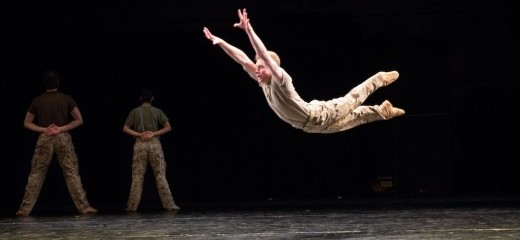
Photo: Alexander Iziliaev
Amazing, Awesome BalletX
by Carolyn Merritt
1. Tick tock clocks, jangling bells, and disparate piano notes tumble over one another and back again in Ben Juodvalkis’s score. Playfully dark to propulsively driving to expansively Eno-esque to densely dub-ish, the sounds push the “flights” at the heart of Norbert De La Cruz III’s world premiere,
Talsikan (tagalog for varied flights, leaps, splashes)
. Women in boneless black corset leotards manipulate thin white tubes (
boning) into ever-changing formations. As these bones shift shape, their more vexing connotations dissolve: Victorian constriction, aristocratic aspiration, classical ballet’s confining female aesthetics, post-feminist sex-positive fetishism, and more, are traded for hula hoops, tails, bumblebee wings, a diver’s airhose, Olympic rings, a playground obstacle course for the men (nearly blasé in their black tunics and loose pants). Later, Caili Quan instigates a Stomp-style protest; she slams, bends, and shouts at her pointe shoes – paramount symbol of female sacrifice to balletic illusion – setting off a company-wide, well, shoe tune.
At various points, the dancers crouch, chests upright, and scurry, covering ground like toddlers let loose: surprisingly fast. They also bounce side-side, not unlike boxers prepping to fight. More often they are airbound, challenging if not outright defying gravity, exploiting one another and the floor to take off. Held aloft by male partners, the women arch like the ringed bones, heads nearly touching feet; the men soar from knees to cartwheels, slowing time at the apex; multiple turns resolve in 180 degree penchés; the women flip up and around the men, into and out of pirouettes, arabesques, oversplits.
Is it an exercise in auto-exoticization? A commentary on ballet’s gendered traditions? A call to subvert its restrictive props to better (more equally) take flight? Does it matter that the subversion is sometimes silly, if entertaining? Can the dancers really come back in 20 minutes for more?
2. The music is somber, cinematic, later buoyant and uplifting in Val Caniparoli’s Triptych, inspired by Lalage Snow’s photographs of soldiers before, during, and after time in Afghanistan. Undifferentiated in camouflage pants and swamp-colored tees, the men and women assemble in lines, march in unison, move into canon, flock like birds. Idiosyncratic gestures disrupt the order. A hand to temple and a shake of the head suggests the involuntary nature of memories, jutting forearms a defense, hands tented over eyes a scene to evade. As their roles diverge, the men carry and support more – flipping and lifting the women towards the sky, swinging them in circles as their feet graze the floor. A rare duet between two men is defused by the context. The sentiment is earnest, solemn, even as the movement – leaps, turns, fouettés en l’air, extensions – is grand.
3. Like Christopher Wheeldon’s
After the Rain, Amy Seiwert’s
It’s Not a Cry takes a famously moving piece of music as background to explore a romantic relationship. But Seiwert’s choice, Leonard Cohen’s
Hallelujah, has achieved cult status. It is everywhere – in books, films, tv shows, and in hundreds of covers (among them the consummate Jeff Buckley version heard here). As lovers hell-bent on union, Chloe Felesina and Richard Villaverde are mesmerizing, and give new definition to the term entangled, even as the choreography suggests the push-pull power dynamic of intimacy and dependency. Wikipedia tells us that Buckley called his version a “hallelujah” to the orgasm. Seiwert seems in accord, though audience members familiar with the track might have a hard time turning off their own private hallelujah playing in their mind’s eye.
4. Amid a petal-covered stage, bare-chested men in blushing beige kilts assume a wide second position, their backs to the audience, reach arms through legs and dramatically wipe their asses. The female counterparts to these campy Highlanders don sheer turtlenecks in the same beige over black bras, panties and thigh highs. A tribute to Cuban American icon La Lupe, Cayetano Soto’s Malasangre (bad blood) is a comedic feast that pairs the singer’s feisty, soulful music with over-the-top, goofily sexualized dance moves. The dancers grab hips, butts, and crotches; chug from the pelvis; drop jaws and cover mouths; shimmy heavily, deeply rooted, in 2nd plie. Deliberately exaggerated, in your face, the work is a moving response to La Lupe’s ultimately tragic life, the result of the profound discrimination she faced as a groundbreaking Latina recording artist in the stiflingly starchy 1960s.
By the end, I am exhausted, distressed at my pen’s inability to keep up. Not just indecipherable, each scribble is interrupted, each response incomplete, my comprehension at a lag in front of so much dazzling information, piled incessantly upon itself. If each of the four works is distinct in theme, there is overlap in the choreographers’ use of movement. With dancers capable of such technical prowess, it is no wonder that the choreography – and/or its execution – tends toward the spectacular. Even as I marvel, “so this is what humans can do now,” I also wonder, what would more space, pedestrian movement, self-conscious criticism of So You Think You Can Dance? aestheticism look like on BalletX? Is it reasonable to ask what more (or what else, or even why) when the company exceeds all expectations, continually raises the bar of dancerly possibilities? Does this brand of movement truly embody the topics at hand? Or does this concern – the connection between the purported message and its medium – simply recede with our admiration? I feel relief at the seldom hop out of a turn: yes, they are flesh and blood. But language falls short of the wonder of their performance, even if the motivation is not always clear.
Winter Series, BalletX, Wilma Theater, February 18-22.
By Carolyn Merritt
February 25, 2015

